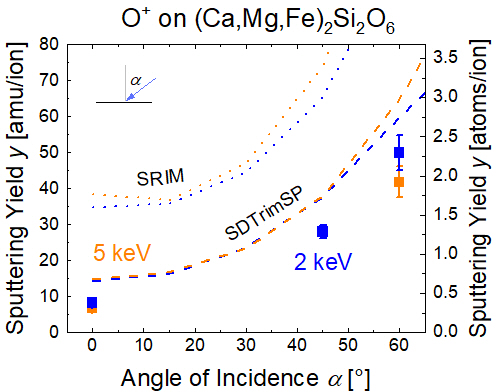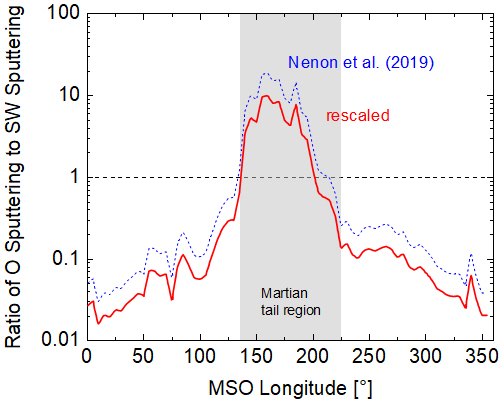Experimental Investigation of Sputtering on Phobos by Atomic and Molecular Ions in the Martian Wake
- 1Institute of Applied Physics, TU Wien, Vienna, Austria
- 2Physics Institute, University of Bern, Bern, Switzerland
- 3Department of Physics and Astronomy, Uppsala University, Lägerhyddsvägen 1, 752 37 Uppsala, Sweden
- 4Institute of Chemical Technologies and Analytics, TU Wien, Vienna, Austria
- 5Max-Planck-Institute for Plasma Physics, Greifswald, Germany
- 6Institute of Geological Sciences, University of Bern, Bern, Switzerland
- 7Space Research Institute (IWF), Austrian Academy of Sciences, Graz, Austria
Experimental quantification of sputtering of planetary surface analogs provides important constraints for the understanding of space weathering [1]. Whereas the Moon and Mars are mostly irradiated by solar wind ions, the Martian moon Phobos is also exposed to atmospheric ions that escape from Mars [2]. In the Martian tail region O+ and O2+ ions at energies of several 100 to several 1000 eV are the predominant contribution to the sputtering of the surface of Phobos [3].
Validating and improving such models requires a more detailed experimental investigation of sputtering with relevant analog samples. Therefore, sputtering experiments with O+, C+, O2+ and CO2+ were performed with energies from 1 to 5 keV, corresponding to energies relevant for Martian ions [4]. Augite (Ca, Mg, Fe)2Si2O6 mineral samples were chosen as a Phobos analog since their elemental composition is close to the current understanding of the composition of Phobos’ surface [5]. Thin films were deposited from augite onto Quartz Crystal Microbalances (QCM), which allow in-situ measurements of sputtering yields [6]. SDTrimSP simulations with established input parameters for augite were performed to compare the simulation outcomes with experimental results [7].

Figure 1 Sputtering yields of 2 keV (blue) and 5 keV (orange) O+ ions under different angles of incidence. Experimental values (dots) are compared to SDTrimSP (dashed lines) and SRIM simulations (dotted lines).
Measured mass changes during O+ and C+ irradiation are slightly smaller than predicted by the SDTrimSP sputtering simulation, which indicates implantation of projectile ions into the samples (for O+ results, see Figure 1). SRIM simulations are known to overestimate sputter yields for such samples, as is also observed here. Measurements with O2+ and CO2+ show no indication of molecular effects. Their behavior is thus equivalent to sputtering by the sum of their atomic constituents at the same velocity.

Figure 2 Calculated ratio of sputtering by atmospheric O ions and solar wind ions. The result from Nenon et al. (blue dashed line) is compared to rescaled calculations on our new experimental data for sputtering by O ions (red line).
For the sputtering of the surface of Phobos, the new experimental results support previous assumptions that only O+ and O2+ ions have to be considered. The sputtering by CO2+ ions is most likely negligible. Regarding the O ions, the new experimental results suggest lower sputtering yields by about 50%. Nevertheless, sputtering in the Martian magnetotail region will still be dominated by atmospheric O ions, as previously calculated (Figure 2) [2, 3]. Over the whole orbit of Phobos, our results predict that atmospheric O ions account for 10 to 15% of the sputtering of Phobos’ surface.
List of References
[1] B. Hapke, J. Geophys. Res.: Planets 106, 10039 (2001).
[2] A.R. Poppe, S.M. Curry, Geophys. Res. Lett., 41, 6335 (2014).
[3] Q. Nenon, et al., J. Geophys. Res.: Planets 124, 3385 (2019).
[4] P.S. Szabo, et al., submitted to J. Geophys. Res.: Planets (2020).
[5] F. Cipriani, et al., Icarus 212, 643 (2011).
[6] G. Hayderer, et al., Rev. Sci. Instrum. 70, 3696 (1999).
[7] A. Mutzke, IPP-Report 2019-02 (2019).
How to cite: Szabo, P. S., Biber, H., Jäggi, N., Wappl, M., Stadlmayr, R., Primetzhofer, D., Nenning, A., Mutzke, A., Fleig, J., Mezger, K., Lammer, H., Galli, A., Wurz, P., and Aumayr, F.: Experimental Investigation of Sputtering on Phobos by Atomic and Molecular Ions in the Martian Wake, Europlanet Science Congress 2020, online, 21 September–9 Oct 2020, EPSC2020-248, https://doi.org/10.5194/epsc2020-248, 2020

